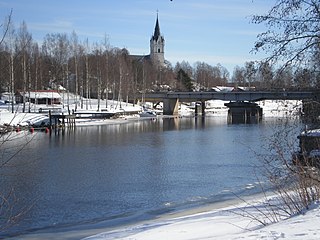
Gösta Berling's Saga is the debut novel of Swedish author Selma Lagerlöf, published in 1891. It was made into a 1924 silent film directed by Mauritz Stiller starring Greta Garbo, Lars Hanson and Gerda Lundequist. A 1925 opera I cavalieri di Ekebù by Riccardo Zandonai was also based on it.

Einar Hanson, also known as Einar Hansen, was a Swedish silent film motion-picture actor.

The Phantom Carriage is a 1921 Swedish film generally considered to be one of the central works in the history of Swedish cinema. Released on New Year's Day 1921, it was directed by and starred Victor Sjöström, alongside Hilda Borgström, Tore Svennberg and Astrid Holm. It is based on the novel Thy Soul Shall Bear Witness!, by Nobel prize-winning Swedish author Selma Lagerlöf.
The Image Makers is a 2000 Swedish television play directed by Ingmar Bergman and written by Per Olov Enquist. The drama is set in the year 1920 at Filmstaden where the film director Victor Sjöström is shooting the film The Phantom Carriage, an adaptation of Selma Lagerlöf's novel Thy Soul Shall Bear Witness! Accompanied by actress Tora Teje and film photographer Julius Jaenzon, he has now invited the book's author to take a first look at some early scenes.
The Selma Lagerlöf Prize is a Swedish literary prize awarded to an author writing in the spirit of Selma Lagerlöf who was the first woman to win the Nobel Prize in Literature. The prize was founded by the Sunne Municipality in 1983 and has been awarded annually since 1984. Recipients receive 100,000 Swedish kronor. The awards ceremony takes place in Sunne every August 13 and is in honor of Selma Lagerlöf.

Sigrid Combüchen is a Swedish novelist, essayist, literary critic and journalist.

Sunne is a locality and the seat of Sunne Municipality, Värmland County, Sweden with 10,000 inhabitants in 2010.

The Lass from the Stormy Croft is a 1917 Swedish drama film directed by Victor Sjöström, based on the 1908 novella with the same title by Selma Lagerlöf. It was the first in a series of successful Lagerlöf adaptions by Sjöström, made possible by a deal between Lagerlöf and A-B Svenska Biografteatern to adapt at least one Lagerlöf novel each year. Lagerlöf had for many years denied any proposal to let her novels be adapted for film, but after seeing Sjöström's Terje Vigen she finally decided to give her consent.
Anna Svärd is a 1928 novel by the Swedish writer Selma Lagerlöf. It is the last installment in Lagerlöf's Ring trilogy; it was preceded by The Löwensköld Ring and Charlotte Löwensköld.
Åke Bertil Lundqvist is a Swedish actor.

Mårbacka is a mansion in Sunne Municipality in Värmland, Sweden. Author Selma Lagerlöf was born and raised at Mårbacka.

The Emperor of Portugallia is a novel by Nobel-laureate Selma Lagerlöf, published in 1914 with drawings by Albert Engström. Lagerlöf called it a "Swedish King Lear". The novel was a success with critics and readers, newspaper reviewers said the novel was at the same level as Lagerlöf's earlier novels Gösta Berling's Saga and the first part of Jerusalem. It has been filmed three times: 1925, 1944 and 1992. An English translation by Velma Swanston Howard was published in 1916.
Jerusalem is a novel by the Swedish writer Selma Lagerlöf, published in two parts in 1901 and 1902. The narrative spans several generations in the 19th century, and focuses on several families in Dalarna, Sweden, and a community of Swedish emigrants in Jerusalem. It is loosely based on a real emigration that took place from the parish of Nås in 1896.
The Treasure is a 1904 novel by the Swedish writer Selma Lagerlöf. Its original Swedish title is Herr Arnes penningar, which means "Mr. Arne's money". It has also been published in English as Herr Arne's Hoard. Set in Bohuslän in the 16th century, it tells the story of a group of Scottish mercenaries who escape from prison; they go on to murder a family to steal a treasure chest, after which one of them falls in love with the family's sole survivor.
The Girl from the Marsh Croft is a 1908 novella by the Swedish writer Selma Lagerlöf. The story has been adapted numerous times for film.
The Löwensköld Ring is a 1925 novel by the Swedish writer Selma Lagerlöf. It has also been published in English as The General's Ring and The Ring of the Löwenskölds. It is the first installment in Lagerlöf's Ring trilogy; it was followed by Charlotte Löwensköld and Anna Svärd.
Charlotte Löwensköld is a 1925 novel by the Swedish writer Selma Lagerlöf. It is the second installment in Lagerlöf's Ring trilogy; it was preceded by The Löwensköld Ring and followed by Anna Svärd. The novel was adapted into a film of the same title in 1930 and again in 1979 starring Ingrid Janbell.
Selma is a feminine name of ambiguous origin. It could be a form of Selima, which in turn is a name first recorded in a poem by Thomas Gray. One possibility is that Selima was influenced by the Arabic name Selim meaning "peaceful". The Turkish name Selma is ultimately of Arabic origin. The use of Selma in Germany and Scandinavia stems from the Ossianic poetry of James Macpherson, where it appears as a place name. Its specific popularity in Sweden is likely due to the Selma poems of Frans Michael Franzén. It was later introduced into Denmark by Swedish immigrants, after which it likely became more common due to the works of the author Selma Lagerlöf.











